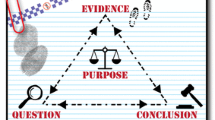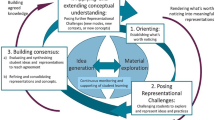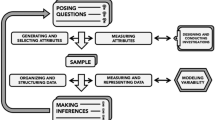Abstract
We explore 11–12-year-old students’ emerging ideas of models and modelling as they engage in a data-modelling task involving inquiry based on data obtained from an experiment. We report on a design-based study in which students identified what and how to measure, decided how to structure and represent data, and made inferences and predictions based on data. Our focus was on the following: (1) the nature of the student-generated models and (2) how students evaluated the models. Data from written work generated by groups and transcripts of interviews were analysed using progressive focussing. The results showed that groups constructed models of actual data by paying attention to various aspects of distributions. We found a tendency to use differing criteria for evaluating the success of models. This data modelling process also fostered students’ making sense of key ideas, tools and procedures in statistics that are usually treated in isolation and without context in school mathematics. In particular, we identified how some students appeared to gain insights into how a ‘good’ statistical model might incorporate some properties that are invariant when the simulation is repeated for small and large sample sizes (signal) and other properties that are not sustained in the same way (noise).






Similar content being viewed by others
References
Ainley, J., & Pratt, D. (2017). Computational modeling and children’s expressions of signal and noise. Statistics Education Research Journal, 16(2), 15–37.
Bakker, A., & Derry, J. (2011). Lessons from inferentialism for statistics education. Mathematical Thinking and Learning, 13(1–2), 5–26.
Cobb, P. (2009). Individual and collective mathematical development: the case of statistical data analysis. Mathematical Thinking and Learning, 1(1), 5–43.
Cobb, P., Confrey, J., DiSessa, A., Lehrer, R., & Shauble, L. (2003). Design experiments in educational research. Educational Researcher, 32(1), 9–13.
Common Core Standards Writing Team. (2013). Progressions for the Common Core State Standards in Mathematics (draft, July 4). High School, Modeling. Tucson: Institute for Mathematics and Education, University of Arizona.
English, L. D. (2010). Young children’s early modelling with data. Mathematics Education Research Journal, 22(2), 24–47.
English, L. D., & Watson, J. (2017). Modelling with authentic data in sixth grade. ZDM Mathematics Education. https://doi.org/10.1007/s11858-017-0896-y.
Fielding-Wells, F., & Makar, K. (2015). Inferring to a model: Using inquiry-based argumentation to challenge young children’s expectations of equally likely outcomes. In A. Zieffler & E. Fry (Eds.), Reasoning about uncertainty: Learning and teaching informal inferential reasoning (pp. 1–28). Minneapolis: Catalyst Press.
Garfield, J., & Ben-Zvi, D. (2008). Learning to reason about statistical models and modeling. In J. Garfield & D. Ben-Zvi (Eds.), Developing students’ statistical reasoning: Connecting research and teaching practice (pp. 143–163). Dordrecht: Springer.
Gravemeijer, K. (2002). Emergent modeling as the basis for an instructional sequence on data analysis. In B. Phillips (Ed.), Proceedings of the sixth international conference on the teaching of statistics (ICOTS-6), Cape Town, South Africa, [CD-ROM]. Voorburg: International Statistical Institute.
Hancock, C., Kaput, J., & Goldsmith, L. (1992). Authentic inquiry with data: Critical barriers to classroom implementation. Educational Psychologist, 27(3), 337–364.
Konold, C., Harradine, A., & Kazak, S. (2007). Understanding distributions by modelling them. International Journal of Computers for Mathematical Learning, 12(3), 217–230.
Konold, C., Higgins, T., Russell, S. J., & Khalil, K. (2015). Data seen through different lenses. Educational Studies in Mathematics, 88(3), 305–325.
Konold, C., & Kazak, S. (2008). Reconnecting data and chance. Technology Innovations in Statistics Education, 2. http://repositories.cdlib.org/uclastat/cts/tise/vol2/iss1/art1. Accessed 21 Apr 2017.
Konold, C., & Miller, C. D. (2011). TinkerPlots 2.0: Dynamic data exploration. Emeryville: Key Curriculum.
Konold, C., Robinson, A., Khalil, K., Pollatsek, A., Well, A. D., Wing, R., & Mayr, S. (2002). Students’ use of modal clumps to summarize data. In B. Phillips (Ed.), Proceedings of the sixth international conference on the teaching of statistics (ICOTS-6), Cape Town, South Africa, [CD-ROM]. Voorburg: International Statistical Institute.
Lehrer, R., & Romberg, T. (1996). Exploring children’s data modelling. Cognition and Instruction, 14(1), 69–108.
Lehrer, R., & Schauble, L. (2002). Investigating real data in the classroom: Expanding children’s understanding of math and science. New York: Teachers College Press.
Lehrer, R., & Schauble, L. (2004). Modeling variation through distribution. American Education Research Journal, 41(3), 635–679.
Lesh, R., & Doerr, H. M. (2003). Foundations of a models and modeling perspective on mathematics teaching, learning and problem solving. In R. Lesh & H. M. Doerr (Eds.), Beyond constructivism: Models and modeling perspectives on mathematics problem solving, learning and teaching (pp. 3–33). Mahwah: Lawrence Erlbaum Associates.
Makar, K., & Rubin, A. (2009). A framework for thinking about informal statistical inference. Statistics Education Research Journal, 8(1), 82–105.
MEB (2018a). Matematik Öğretim Programı (İlkokul ve Ortaokul 1, 2, 3, 4, 5, 6, 7 ve 8. Sınıflar). Ankara: TTKB.
MEB. (2018b). Matematik Öğretim Programı (9, 11 ve 12. Sınıflar) (p. 10). Ankara: TTKB.
Moore, D. S. (1990). Uncertainty. In L. Steen (Ed.), On the shoulders of giants: New approaches to numeracy (pp. 95–137). Washington, DC: National Academy Press.
Moore, D. S. (1999). Discussion: What shall we teach beginners? International Statistical Review, 67(3), 250–252.
Noll, J., & Kirin, D. (2017). TinkerPlots model construction approaches for comparing two groups: Student perspectives. Statistics Education Research Journal, 16(2), 213–243.
Parlett, M., & Hamilton, D. (1972). Evaluation as illumination: A new approach to the study of innovatory programs, Occasional Paper no 9. University of Edinburgh, Centre for Research in the Educational Sciences, Edinburgh. (Retrieved from ERIC database (ED167634).
Pratt, D., & Noss, R. (2010). Designing for mathematical abstraction. International Journal of Computers for Mathematical Learning, 15(2), 81–97.
Sfard, A. (1991). On the dual nature of mathematical conceptions: Reflections on processes and objects as different sides of the same coin. Educational Studies in Mathematics, 22(1), 1–36.
Tall, D., & Gray, E. (1991). Duality, ambiguity and flexibility: A proceptual view of simple arithmetic. The Journal for Research in Mathematics Education, 26(2), 115–141.
Wild, C. J., & Pfannkuch, M. (1999). Statistical thinking in empirical inquiry. International Statistical Review, 67(3), 223–248.
Acknowledgements
This work was supported by PAU-ADEP 2017KRM002-159. We would also like to acknowledge insightful and constructive feedback from all reviewers and editor of this manuscript, and the generous work of the students who participated in this study.
Author information
Authors and Affiliations
Corresponding author
Rights and permissions
About this article
Cite this article
Kazak, S., Pratt, D. & Gökce, R. Sixth grade students’ emerging practices of data modelling. ZDM Mathematics Education 50, 1151–1163 (2018). https://doi.org/10.1007/s11858-018-0988-3
Accepted:
Published:
Issue Date:
DOI: https://doi.org/10.1007/s11858-018-0988-3




